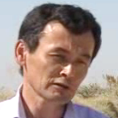In the fall, the land rolls parched and brown into the foothills. But in the valleys, bright green fields cover the flat land, filled with fruit and vegetables ready for harvest. 94 percent of the Kyrgyz Republic is mountainous and not fit for farming. So the remaining land, and the water that feeds it, are crucial to the country’s food supply. And the Kyrgyz economy relies on it; agriculture accounts for about a fourth of the country’s GDP and about a third of its employment.
Collapse and Rebirth
After the fall of the Soviet Union, and the breakup of the huge collective farms, the Kyrgyz Republic’s irrigation systems began to physically deteriorate. And the money and social fabric that kept the systems working began to fray as well. The concrete decayed, while small private farmers sometimes fought over access to water.
To ensure water availability, with support from the World Bank, farmers began forming Water Users’ Associations to regulate and maintain the water supply. “The main change is that farmers get enough water when they need it. In the past, farmers would fight over water, to whose fields it went; that doesn’t happen anymore,” explains Tilekbek Matraimov, who runs the Kara Suu Regional Administration.


